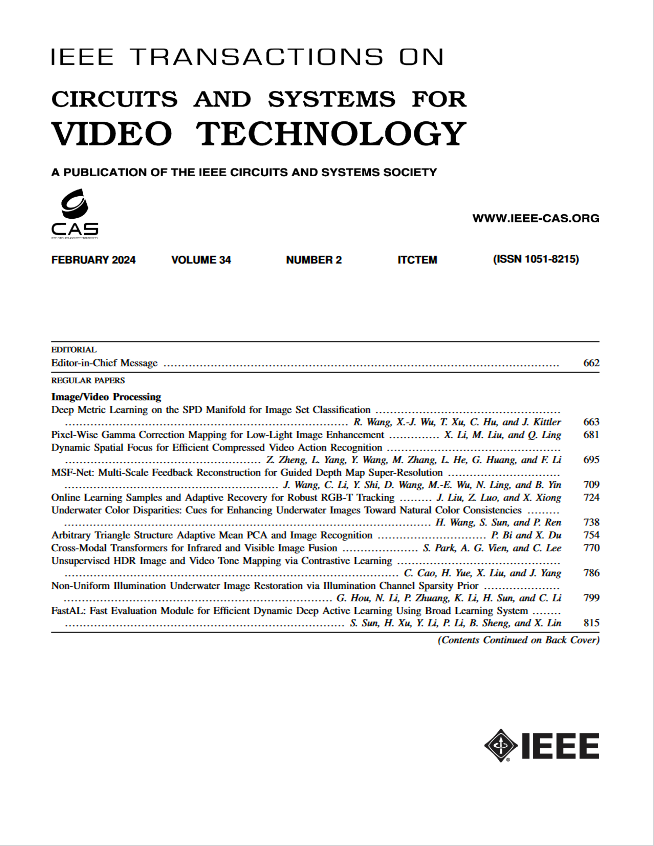基于特征解缠和动态内容失真制导的水下图像质量评估
IF 11.1
1区 工程技术
Q1 ENGINEERING, ELECTRICAL & ELECTRONIC
IEEE Transactions on Circuits and Systems for Video Technology
Pub Date : 2025-01-24
DOI:10.1109/TCSVT.2025.3533598
引用次数: 0
摘要
由于水下成像过程复杂,水下图像包含各种独特的畸变。虽然现有的水下图像质量评估(UIQA)方法在强调这些失真方面取得了进展,但它们忽略了这样一个事实,即图像内容也会影响失真的感知方式,因为不同的内容对不同类型的失真表现出不同的敏感性。内容本身的特性和失真的特性决定了水下图像的质量。此外,水下图像的内容和失真特征交织在一起,使两者的准确提取变得复杂。在本文中,我们通过综合考虑内容和失真信息并明确地将水下图像特征分解为内容和失真组件来解决这些问题。为了实现这一目标,我们引入了一个动态内容失真引导和特征解纠缠网络(DysenNet),该网络由三个主要组成部分组成:特征解纠缠子网络(FDN)、动态内容引导模块(DCM)和动态失真引导模块(DDM)。具体来说,FDN将水下特征分解为内容元素和失真元素,使我们能够更清楚地衡量它们各自对图像质量的贡献。DCM根据每张图像的独特内容生成动态多尺度卷积核,从而实现内容自适应特征提取,以实现质量感知。另一方面,DDM通过从信道和空间角度识别失真线索来解决全球和局部水下失真问题,重点关注严重退化的区域和信道。在UIQA数据集上的大量实验证明了所提出方法的最先进性能。本文章由计算机程序翻译,如有差异,请以英文原文为准。
Underwater Image Quality Assessment Using Feature Disentanglement and Dynamic Content-Distortion Guidance
Due to the complex underwater imaging process, underwater images contain a variety of unique distortions. While existing underwater image quality assessment (UIQA) methods have made progress by highlighting these distortions, they overlook the fact that image content also affects how distortions are perceived, as different content exhibits varying sensitivities to different types of distortions. Both the characteristics of the content itself and the properties of the distortions determine the quality of underwater images. Additionally, the intertwined nature of content and distortion features in underwater images complicates the accurate extraction of both. In this paper, we address these issues by comprehensively accounting for both content and distortion information and explicitly disentangling underwater image features into content and distortion components. To achieve this, we introduce a dynamic content-distortion guiding and feature disentanglement network (DysenNet), composed of three main components: the feature disentanglement sub-network (FDN), the dynamic content guidance module (DCM), and the dynamic distortion guidance module (DDM). Specifically, the FDN disentangles underwater features into content and distortion elements, allowing us to more clearly measure their respective contributions to image quality. The DCM generates dynamic multi-scale convolutional kernels tailored to the unique content of each image, enabling content-adaptive feature extraction for quality perception. The DDM, on the other hand, addresses both global and local underwater distortions by identifying distortion cues from both channel and spatial perspectives, focusing on regions and channels with severe degradation. Extensive experiments on UIQA datasets demonstrate the state-of-the-art performance of the proposed method.
求助全文
通过发布文献求助,成功后即可免费获取论文全文。
去求助
来源期刊
CiteScore
13.80
自引率
27.40%
发文量
660
审稿时长
5 months
期刊介绍:
The IEEE Transactions on Circuits and Systems for Video Technology (TCSVT) is dedicated to covering all aspects of video technologies from a circuits and systems perspective. We encourage submissions of general, theoretical, and application-oriented papers related to image and video acquisition, representation, presentation, and display. Additionally, we welcome contributions in areas such as processing, filtering, and transforms; analysis and synthesis; learning and understanding; compression, transmission, communication, and networking; as well as storage, retrieval, indexing, and search. Furthermore, papers focusing on hardware and software design and implementation are highly valued. Join us in advancing the field of video technology through innovative research and insights.

 求助内容:
求助内容: 应助结果提醒方式:
应助结果提醒方式:


